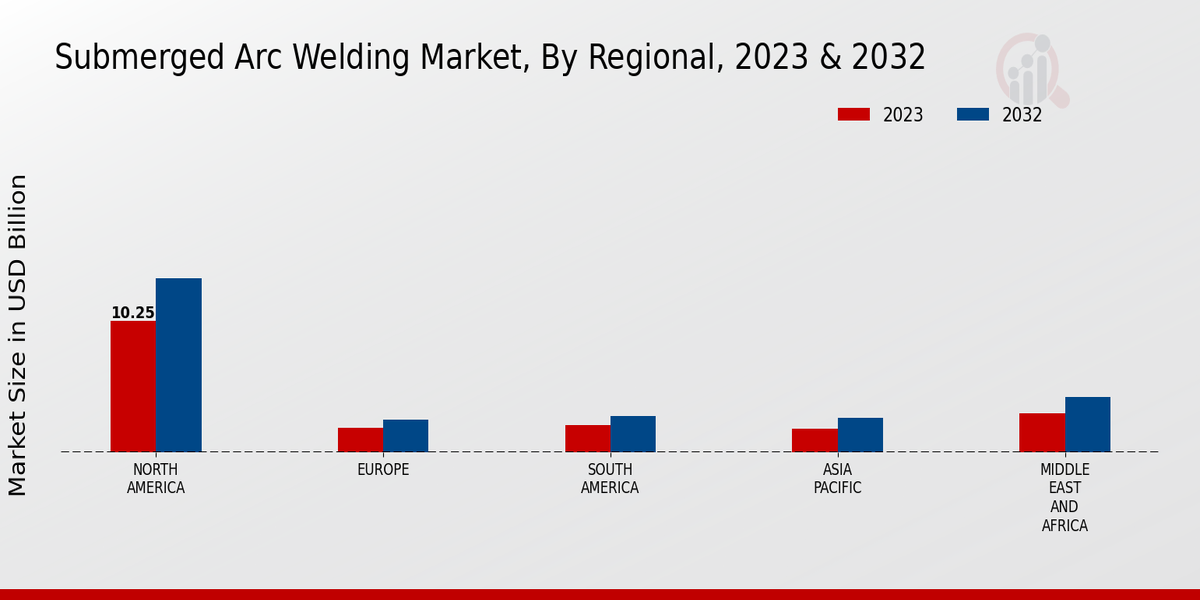Market Growth Projections
The Global Submerged Arc Welding Market Industry is poised for substantial growth, with projections indicating a market value of 13.7 USD Billion in 2024 and an anticipated increase to 19.9 USD Billion by 2035. This growth trajectory suggests a compound annual growth rate (CAGR) of 3.43% from 2025 to 2035. Factors contributing to this expansion include rising demand from various sectors such as construction, shipbuilding, and automotive manufacturing, as well as advancements in welding technology. The market's evolution reflects the increasing reliance on submerged arc welding as a preferred method for achieving high-quality welds in diverse applications.
Expansion of Automotive Manufacturing
The automotive manufacturing sector significantly drives the Global Submerged Arc Welding Market Industry, as submerged arc welding is employed in producing various vehicle components. The increasing production of electric vehicles and the need for lightweight materials necessitate advanced welding techniques that ensure structural integrity and performance. As automotive manufacturers seek to enhance production efficiency and meet stringent safety standards, the adoption of submerged arc welding is likely to rise. This trend indicates a robust market outlook, as the automotive industry continues to evolve and innovate, further solidifying the role of submerged arc welding in vehicle manufacturing.
Increasing Focus on Energy Efficiency
Energy efficiency remains a critical concern across various industries, impacting the Global Submerged Arc Welding Market Industry. As companies strive to reduce energy consumption and minimize environmental impact, the demand for welding processes that offer energy-efficient solutions is growing. Submerged arc welding, known for its low energy consumption compared to other welding methods, is increasingly favored. This trend aligns with global sustainability goals, prompting industries to adopt practices that contribute to energy savings. The shift towards energy-efficient technologies is expected to bolster the market, as organizations prioritize sustainable operations in their welding processes.
Growing Demand from Shipbuilding Industry
The shipbuilding industry significantly influences the Global Submerged Arc Welding Market Industry, as submerged arc welding is extensively utilized in constructing large vessels. The method's ability to produce strong and reliable welds is crucial for ensuring the structural integrity of ships. With the global shipping industry expanding, driven by increased trade and transportation needs, the demand for submerged arc welding is likely to rise. This sector's growth is expected to contribute to the market reaching 19.9 USD Billion by 2035, highlighting the importance of this welding technique in meeting the rigorous standards of shipbuilding.
Technological Advancements in Welding Equipment
Technological innovations play a pivotal role in shaping the Global Submerged Arc Welding Market Industry. The introduction of advanced welding equipment, such as automated systems and improved fluxes, enhances the efficiency and quality of welding processes. These advancements not only reduce operational costs but also minimize the risk of defects, thereby increasing productivity. As industries seek to optimize their operations, the adoption of these technologies is likely to rise. The market is expected to grow at a CAGR of 3.43% from 2025 to 2035, driven by continuous improvements in welding technology that cater to diverse industrial applications.
Rising Demand in Construction and Infrastructure
The Global Submerged Arc Welding Market Industry experiences a surge in demand driven by the construction and infrastructure sectors. As urbanization accelerates, the need for robust and durable structures increases, leading to a higher adoption of submerged arc welding techniques. This method is favored for its efficiency and ability to produce high-quality welds, particularly in large-scale projects such as bridges and buildings. The market is projected to reach 13.7 USD Billion in 2024, reflecting the growing reliance on advanced welding technologies to meet construction demands. The emphasis on infrastructure development in emerging economies further propels this trend, indicating a sustained growth trajectory.





















Leave a Comment